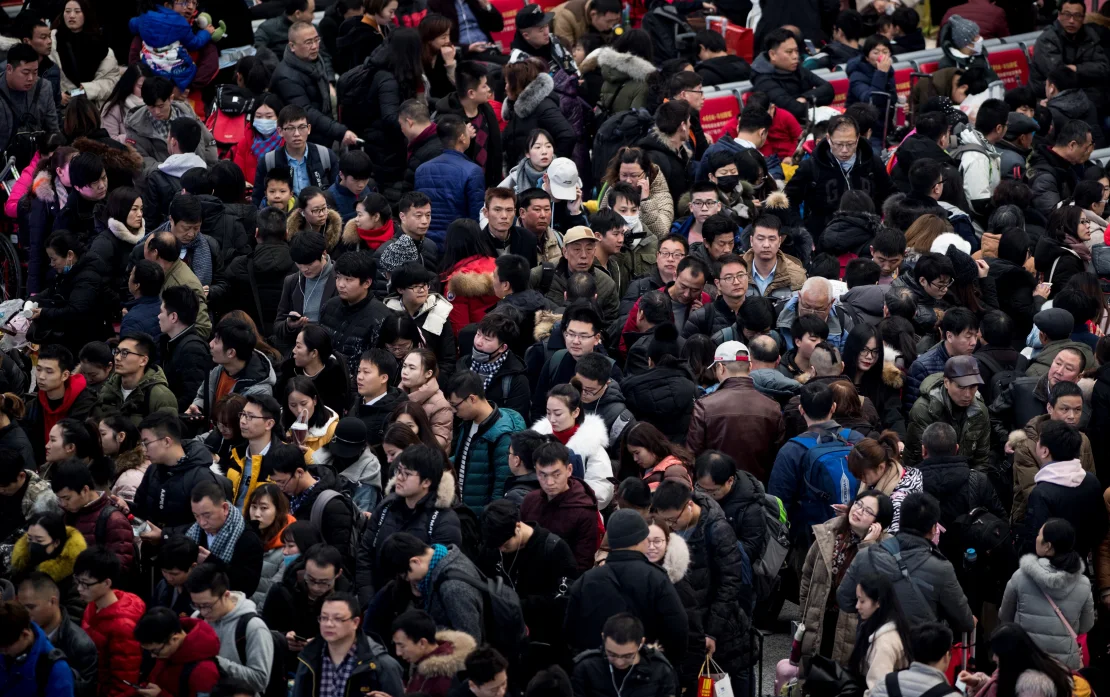
China's Population Decline
China’s population decline presents significant economic challenges, necessitating strategic adjustments and innovative growth models to sustain development amid a decreasing labor force and aging population.
By | Shiyu Li,
JUNE 27, 2024 | 07:24 PM

In 2023, China’s population declined for the second consecutive year, a trend that holds immense significance in the demographic landscape. The total population decreased by 2.08 million to 1.409 billion, a decrease of 0.15%. This significant shift in China’s population dynamics has sparked widespread discussions, including the reasons for population decline, prospects, and potential impacts on China’s economy and society. It is a pressing issue that demands the attention of policymakers, economists, and sociologists for in-depth research.
The prospects for population decline are unsurprising for over half of the countries and economies. According to the United Nations Population Fund’s statistics on the birth rates of 204 countries and economies in 2023, only 99 economies maintained birth rates above 2.1 required for population replacement. Some economies that are below the standards of developed or moderately developed countries have also experienced a slowdown in population growth, such as India (2.0), Bangladesh (1.9), and Vietnam (1.9).
The experience of East Asian societies, also known as the Confucian cultural sphere (Sinosphere), can be treated as a group of appropriate samples since some deeply ingrained values influence these countries at the social and family level. These values, such as the old sayings in China: He who excels in study should follow an official career (Xue Er You Ze Shi), and More happiness comes with more offspring (Duo Zi Duo Fu), continue to shape these countries in contemporary times. For example, parents prioritize supporting their kids financially in university and preparing for the national civil service exams rather than working in handicrafts and agriculture.
Meanwhile, fathers and mothers encourage or even pressure their sons or daughters to start a family early in their career (usually around 25) and fulfill “carrying on the family line.” This situation is most evident in China, where the average age of first marriage was only 24.89 years old in 2010, the year China surpassed Japan to become the world’s second-largest economy (30.5 of males and 28.8 of females in Japan, 2010). These cultural and historical factors intricately contribute to the issue of China’s population decline, adding depth and complexity to the analysis.
China’s population issue is not just a consequence of its Confucian cultural heritage but also influenced by its unique economic and political circumstances. Comparing it to other countries and economies with Confucian traditions in East Asia and Southeast Asia, such as Japan, South Korea, Singapore, and Taiwan, we can see that these economies experienced varying degrees of negative population growth between 2009 and 2020.
However, in the year of their first negative population growth, these economies had already reached the standards of developed economies, ranging from $28.400 in Taiwan to $61.200 in Singapore. In 2022, when China’s population experienced its first negative growth, its per capita GDP was only $12.700, which was not considered a developed economy according to the standard made by most international organizations. These unique economic and political circumstances of China further complicate the issue of population decline.
In order to understand and forecast China’s population’s current and future trends, it is crucial to delve into the historical stages of China’s population policy, which is characterized by its high level of political and strategic orientation. In an academic paper titled ‘Explaining the Historical Stages of China’s Population Policy: A Perspective on the Transformation of Political Elite Ideology,’ three researchers, Liu Ji, Xiong Cai, and De Xinjian, from the South China University of Technology and the University of Hong Kong, raised the question of why China’s one-child policy was not fully implemented in the era of the planned economy (1949-1978) but in the period of the market economy (after 1978)? This historical perspective provides a deeper understanding for various readers.
In the 1950s and 1960s, the Chinese government proposed schemes to control the rapid population growth and eliminate poverty. However, the specific implementation of these schemes was influenced by the Cold War atmosphere and the will of the Chinese leadership. On September 16, 1949, Chairman of the Chinese Communist Party Mao Tse-tung wrote an article titled The Bankruptcy of the Idealist Conception of History. Mao severely criticized US Secretary of State Acheson’s pessimistic prediction of the contradiction between China’s population and land.
Dean Acheson believed that a communist line of land revolution could not solve China’s social problems. In this context, the population issue in China became a test ground for debates between Marxist population theory and Western bourgeois demographers such as Thomas Robert Malthus. Mao stated, ‘It is a perfect thing that China has a big population. Even if the population multiplies many times, China is fully capable of finding a solution. The solution is production.’
In the 1950s and 1960s, China imitated the Soviet Union in awarding honorary titles of Mother Heroine to the ladies who had given birth to multiple children. At the same time, scholars and politicians in China who supported the population control policy were almost unable to express their voices for an extended period. Chinese demographer Professor Ma Yinchu was forced to resign from his position as President of Peking University in 1960 due to his publication of the article “New Population Theory” in People’s Daily, supporting the proposition that “China’s population growth is too fast” and believing that it is necessary to implement family planning while implementing a planned economy.
Liu Ji, Xiong Cai, and De Xinjian (2015: 28) concluded that in terms of the upper echelons of national decision-making, the Mao Zedong era was a stage of ongoing conflict between planned-economy thinking and communist revolutionary discourse, where two mechanisms of encouraging and controlling population coexisted. The political and economic differences among leaders led to significant disagreements over population policy, making it challenging for the country to launch a consistent birth control policy. On the contrary, in the era of market economy, market-oriented thinking continues to expand at the social level.
However, at the level of national decision-making, where revolutionary discourse has been abandoned, planned thinking has reached a high degree of conceptual consistency with the discourse of development, and population control has become a basic consensus to ensure the implementation of national development strategies. The planned thinking, as referenced here, does not mean China keeps implementing a centrally planned economy but rather a ‘command’ market economy. For instance, The Chinese government prolonged the development model of making the “Five Year Plans” (The entire name is the Five-Year Plan for National Economic and Social Development of the People’s Republic of China) after 1978 instead of turning to a management system of “small government, big society” to allow social institutions and organizations play a dominant role.
The issue of population is essential to China’s national economy and social development. A chapter introduces China’s population policy and population challenges in the five-year plans outline released by the Chinese government every five years. The Chinese government first proposed in the five-year plan to strictly control the population through the family planning policies (the so-called ‘One Child Policy’) in the sixth five-year plan formulated in 1981.
This policy orientation lasted until the Twelfth Five Year Plan for National Economic and Social Development of the People’s Republic of China (2011-2016) was formulated in 2011, emphasizing the increase in subsidies for families obeying the family planning rules. From the 13th Five-Year Plan issued in 2016, the Chinese government’s population policy suddenly shifted toward how to respond to population aging, such as allowing one family to have two children. From the perspective of the number of births in the following years of 2016, the “two-child policy” has not solved the problem of the upcoming decline in fertility rates in China.
From the experience of changes in birth rates in economies in East Asia and other parts of the world, reducing birth rates through administrative directives is a target within the realm of possibility. However, with rapid economic development and urban expansion, the birth rate will gradually decline and fall below the replacement rate of 2.1. In the latter case, more than administrative directives and economic incentives are needed to reverse the decline trend. Beijing once controlled rapid population growth.
It ensured the rational allocation of national resources through almost the strictest family planning policy in the world for over 40 years. However, it is almost impossible for China to force the public to have children through the same administrative order to alleviate the potential population crisis. The Chinese government released the 14th Five-Year Plan in 2021. It can be seen from the plan that China no longer attempts to solve population problems through any administrative directive but only emphasizes promoting long-term balanced population development.
The potential impact of China’s population decline on its economy is a topic of debate, with two main perspectives: pessimistic and optimistic. These views often rely on vague speculations and scattered information. For example, some may draw parallels with Japan’s experience since 1990, link China’s low birth rates with COVID-19, or even conclude that investors have lost confidence in the Chinese market due to the population decline. However, it is crucial to approach these speculations cautiously and consider a broader perspective, as the situation is complex and multifaceted.
This article does not intend to respond to these negative or positive subjective speculations but instead aims to propose a new perspective: population is not the only factor determining China’s economic prospects. Take the proportion of China’s population and total economic output to the world’s population and economy in history as an example. According to official data in Chinese historical archives, Qing shilu (Veritable Records of Qing), and the research by a British economic historian, Angus Maddison, China had approximately 350 million people (34% of the world’s total population) in 1820.
Its total economic output accounted for 33% of the world’s total (much higher than 18% in 2023), making it the world’s largest economy at that time. However, by 1900, China’s population had increased to 400 million (approximately 1/4 of the world’s total population), and its share of the world economy had decreased to 6%. The rapid decline of China from 1820 to 1900 was not a result of the decrease in population but instead of a lack of modernization in all aspects, including political system, material and ideological aspects, which could not adapt to the rapid changes in the external environment.
For today’s China, the decline in the birth rate does indeed require macro adjustments to how China develops its economy. China may be unable to sustain rapid economic growth by relying on its domestic real estate demand advantages and low labor costs after 10-20 years. However, the population issue is only one of the challenges that China should overcome. A primary task that China needs to overcome shortly is exploring a high-value-added economic growth model in the context of a decreasing labor force.
